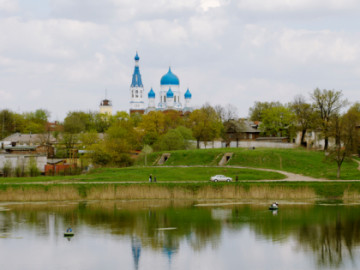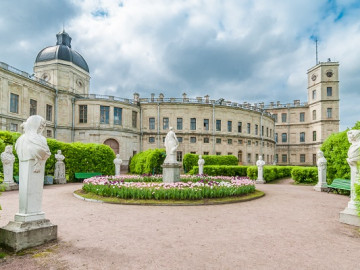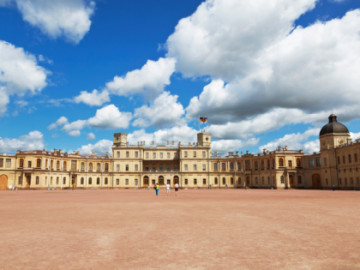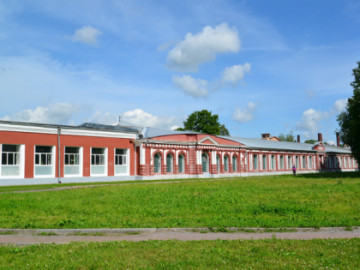«Yegerskaya Sloboda» and Imperial Hunting
«Yegerskaya Sloboda» architectural ensemble in Gatchina is one of the first examples of standard housing in Russian history. This residential complex was built by architect Georg Gross in the mid-XIX century for the court imperial hunt. The author himself was entitled academician for the plan implementation. «Yegerskaya Sloboda» served as a source of inspiration for Russian artists: in particular, Alexei Savrasov and Vasily Vereshchagin worked there.
Yegerskaya Sloboda consisted of 60 buildings, including a hunting department, a clerical space, a school, a barrack for unmarried hunters and separate houses for married people, a bathhouse, a stable and other buildings. The complex adjoined a century-old forest where roe deer were kept and the house of the chief of the imperial hunt was located. Total of 25 houses have been preserved in the complex until now: classical Russian huts with gable roofs, carved shutters and casings. The Church of the Intercession of the Mother of God, built in the 1880s, successfully fits in with the ensemble of the Sloboda. This is a seven-headed temple with elements of Old Russian architecture — corbel arches and pilasters — in the facade decoration. All the decoration of the church was made in St. Petersburg, except for the icons made by a Moscow master.
GPS coordinates
59.56722877532851, 30.08304476737976
Official website
Opening Hours
Now - open
Mon-Sun
00:00-24:00
Nearby

St. Paul’s Cathedral
Temples and places of worship • Cathedrals and churches • Other places

Bez adresa
Bistro • Café • Catering
+7 812 7481588
Payment methods:

Budu kofe
Coffee shop • Patisserie
+7 921 9262606
Payment methods:

Solenya-Varenya
Restaurant • Banquet room
+7 812 4652685
Payment methods:

San-Piccerino
Patisserie • Pizzeria • Catering
+7 812 9870097
Payment methods:

Architectural Monuments • Parks and recreation • Castles, Fortresses and Palaces

White Rabbit
Restaurant • Banquet room
+7 812 4663388
Payment methods:

Gatchina Palace
Museums and Exhibitions • Castles, Fortresses and Palaces

Voyazh
Restaurant • Hotel • Café
+7 812 6455550
Payment methods:

Kafe
Café
+7 812 3395483
Payment methods:

Pomeste
Restaurant • Banquet room • Café
+7 812 4662958
Payment methods:

MANANA Meet & Sweet
Restaurant • Banquet room • Grill bar • Hookah bar
+7 812 9046900
Payment methods:

Carskoselskij Prezent
Restaurant • Banquet room • Café • Catering
+7 812 4519222
Payment methods:

Oхotnichya Usadba
Restaurant • Banquet room • Hotel • Bar
+7 812 4145774
Payment methods:

Pevcheskaya Bashnya
Restaurant • Karaoke • Bar
+7 812 9010808
Payment methods:

Uno Cafe
Restaurant • Catering
+7 812 4668323

Complimento
Restaurant • Hotel • Bar
+7 812 3335242

Moх
Café
+7 981 9583990
Payment methods:

Piramida-Express
Pizzeria
+7 812 4545383
Payment methods:

Pushkin Cake
Patisserie • Café • Bakery
+7 931 2296499
Payment methods:

Podvore
Restaurant
+7 812 4545464

Fortunato
Pizzeria
+7 812 4514441
Payment methods:

Chelentano
Restaurant • Karaoke • Pizzeria • Catering
+7 812 4665743
Payment methods:

Admiraltejstvo
Restaurant • Banquet room • Catering
+7 812 4653549
Payment methods:

Voyazh
Banquet room • Hotel • Café
+7 812 7044609
Payment methods:

BIP
Restaurant • Hotel
+7 812 2442828
Payment methods:

Lemonade
Bar • Café
+7 812 4658687
Payment methods:

Museum of Aviation Engine-Building
Museums and Exhibitions

Rekon
Restaurant
+7 812 4762603

Bakenbardy
Karaoke • Banquet room • Café
+7 812 9960235
Payment methods:

Nyam-nyam
Patisserie • Bistro • Café
+7 812 3807350
Payment methods:

Mechta
Restaurant • Patisserie • Catering
+7 812 4517280
Payment methods:

Yalta
Restaurant • Banquet room
+7 812 4662898
Payment methods:

Russkij chaj
Restaurant
+7 812 4654824

